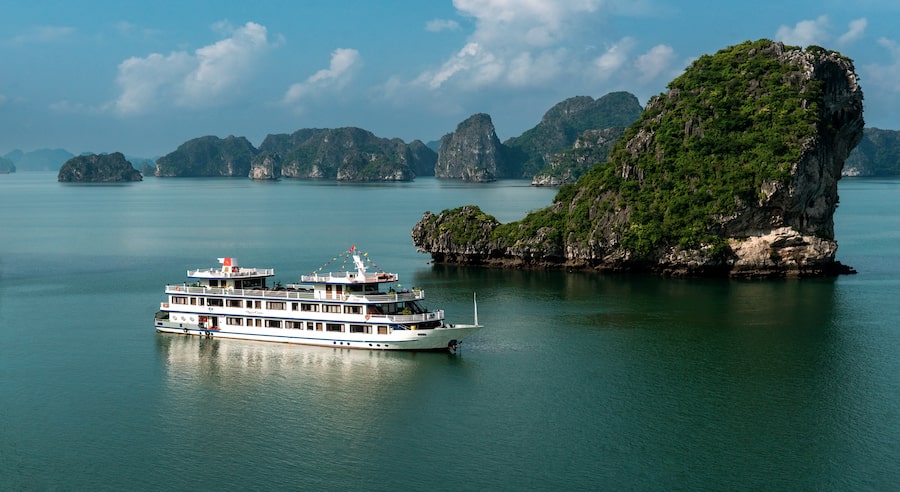
Ha Long Bay is truly a gift that nature has bestowed upon Vietnam, featuring majestic limestone mountains rising from emerald waters like a mysterious and poetic painting. Many international tourism organizations have ranked Ha Long Bay highly among the world’s most beautiful bays.
Recently, the world-famous travel website Touropia voted Ha Long Bay the most beautiful bay on the planet, placing it first on their list of the top 10 most stunning bays globally. UNESCO has also recognized Ha Long Bay as a World Heritage Site, making it one of Vietnam’s premier destinations, attracting millions of visitors each year.
Location and Area
Ha Long Bay is located in the Gulf of Tonkin. It borders Bai Tu Long Bay to the northeast, Cat Ba Islands to the southwest, the Vietnamese mainland to the west and northwest, and faces the Northern Gulf to the southeast and south.
The bay covers a total area of 1,553 km², comprising core zones and buffer zones, with 1,969 large and small islands (989 named and 980 unnamed). Ha Long Bay also boasts a 120 km coastline.
Environment and Climate
Ha Long Bay experiences two distinct seasons:
- Summer (April – October): Warm, humid weather with average temperatures around 27-29°C.
- Winter (November – March): Cooler and drier, with temperatures around 16-18°C.
The average annual temperature ranges from 15-25°C, creating a perfect climate for tourism throughout the year. Ha Long Bay attracts both international and domestic tourists, especially during long holiday periods.
Read more: [Quang Ninh Museum – A “Must-Visit” Place Near Ha Long Bay]
The Best Time to Visit Ha Long Bay
Although Ha Long Bay is beautiful year-round, each season has unique characteristics:
- April to July: Peak time for domestic tourists, especially families on summer holidays. Visitors enjoy swimming, scenic cruises, and exploring caves. However, this period can see occasional storms, causing some activities to be canceled.
- September to November: Sunny, pleasant weather perfect for swimming and sightseeing, with fewer tourists than in peak season.
- November to March: Ideal for international tourists who wish to explore attractions, amusement parks, and enjoy delicious local cuisine.
Famous Islands, Islets, and Caves in Ha Long Bay
Tuan Chau Island
Located just 2 kilometers from central Ha Long, Tuan Chau is one of the bay’s top tourist attractions. Its Tuan Chau International Port can accommodate over 1,000 ships, making it the primary departure point for day and overnight cruises around Ha Long Bay.
Soi Sim Island
A small island nestled on Ha Long Bay’s western side, Soi Sim is named after the rose myrtle (sim in Vietnamese), a plant that grows abundantly across the island.
Titop Island
Originally called Titov Island, it was named in honor of Russian cosmonaut Gherman Titov, who visited the island with President Ho Chi Minh in 1962. Located at the head of Ha Long Bay, Titop offers spectacular panoramic views of the bay and is a popular spot for swimming.
Bo Hon Island
A favorite among visitors, Bo Hon Island is surrounded by numerous small islands and is home to famous grottoes, including Sung Sot Cave (Surprise Cave), Luon Cave, Trinh Nu Cave, and Trong Cave (Drum Cave). The island’s dramatic limestone cliffs create unforgettable scenery.
Read more: [Bai Tu Long Bay – An Alternative to Ha Long Bay]
Cat Ba Island
Known as the “Pearl Island” of the Gulf of Tonkin, Cat Ba Island is the largest and one of the most popular stops in the Ha Long Bay region. The island is home to Cat Ba National Park, Vietnam’s first national park combining terrestrial and marine ecosystems. It’s perfect for hiking and exploring diverse wildlife.
Co To Island
Co To Island is a cluster of 50 islands featuring pristine beaches, long stretches of white sand, and clear blue waters. Touring the island by motorbike is highly recommended for a full experience of its stunning natural landscapes.
Other Caves and Islets
Ha Long Bay is renowned for its spectacular caves, each with unique formations and legends:
- Sung Sot Cave (Surprise Cave): Known for its impressive stalactites and a hidden clear lake surrounded by rich flora and fauna.
- Dau Go Cave: The largest limestone cave in Ha Long Bay, dating back nearly two million years, adorned with colorful stalactites, moss, and lush vegetation.
- Luon Cave: Famous for its delicate stalactite buds of varying shapes and colors.
- Thien Cung Cave: Located on Dau Go Island, featuring dramatic rock formations, towering ceilings, and a cool atmosphere.
- Kim Quy Cave: Approximately 100 meters long and 5-10 meters wide, with water flowing over its stalactites, creating a magical scene.
Ha Long Old Quarter
Ha Long Old Quarter is designed to mimic the architecture of Hanoi’s Old Quarter and Hoi An Ancient Town. Its narrow alleys, yellow-painted houses, and quaint atmosphere evoke a nostalgic charm. The area offers a variety of food, drinks, and entertainment options for tourists.
Sun World Ha Long Park
Sun World Ha Long Park is Vietnam’s largest amusement park, covering 214 hectares. It features:
- Mystic Mountain Complex (Ba Deo Hill Park)
- Coastal Amusement Complex, including the popular Typhoon Water Park
Ba Vang Pagoda and Yen Tu Relic Site
These spiritual sites are must-visit destinations for those seeking cultural and religious experiences:
- Ba Vang Pagoda: Located halfway up Thanh Dang Mountain, offering tranquility and fresh air.
- Yen Tu Relic: Situated on Dong Trieu Mountain at an altitude of 1,068 meters. This sacred site was where Emperor Tran Nhan Tong founded the Truc Lam Zen sect. Visitors can explore historical temples and climb stone steps to Dong Pagoda for breathtaking views above the clouds.
Conclusion
Ha Long Bay is a true natural wonder, combining breathtaking landscapes, cultural heritage, and exciting activities. Whether you’re exploring hidden caves, relaxing on pristine beaches, or discovering ancient temples, Ha Long Bay offers an unforgettable journey through one of the world’s most beautiful natural landscapes.



